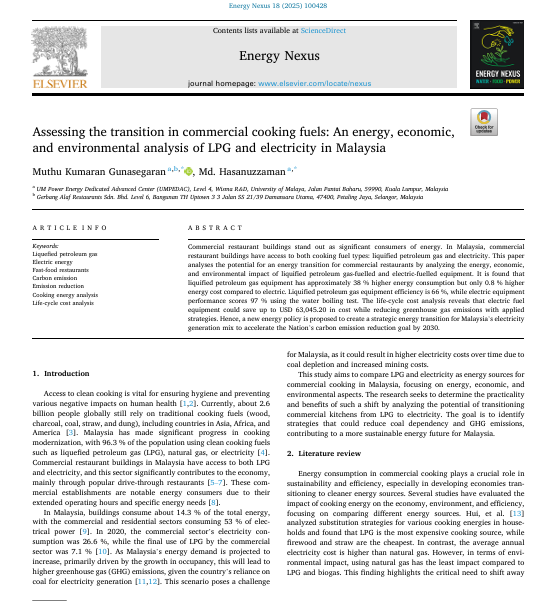
Keyword(s)
Author(s)
Muthu Kumaran Gunasegaran, Md. Hasanuzzaman
Country(ies)
Publisher
Published Date
Access
DOI
1. UM Power Energy Dedicated Advanced Center (UMPEDAC), Level 4, Wisma R&D, University of Malaya, Jalan Pantai Baharu, 59990, Kuala Lumpur, Malaysia
2. Gerbang Alaf Restaurants Sdn. Bhd. Level 6, Bangunan TH Uptown 3 3 Jalan SS 21/39 Damansara Utama, 47400, Petaling Jaya, Selangor, Malaysia
Commercial restaurant buildings stand out as significant consumers of energy. In Malaysia, commercial restaurant buildings have access to both cooking fuel types: liquified petroleum gas and electricity. This paper analyses the potential for an energy transition for commercial restaurants by analyzing the energy, economic, and environmental impact of liquified petroleum gas-fuelled and electric-fuelled equipment. It is found that liquified petroleum gas equipment has approximately 38 % higher energy consumption but only 0.8 % higher energy cost compared to electric. Liquified petroleum gas equipment efficiency is 66 %, while electric equipment performance scores 97 % using the water boiling test. The life-cycle cost analysis reveals that electric fuel equipment could save up to USD 63,045.20 in cost while reducing greenhouse gas emissions with applied strategies. Hence, a new energy policy is proposed to create a strategic energy transition for Malaysia’s electricity generation mix to accelerate the Nation’s carbon emission reduction goal by 2030.